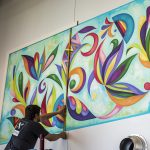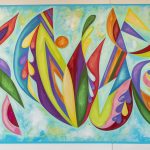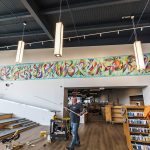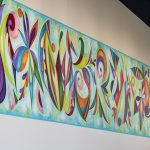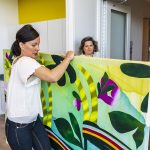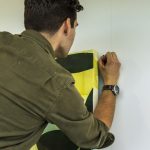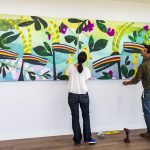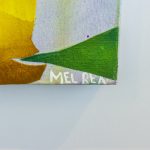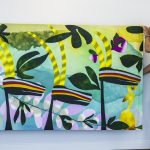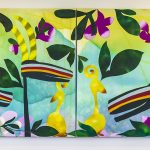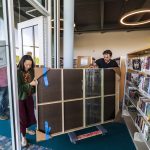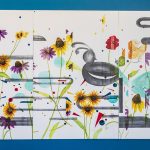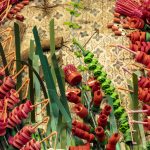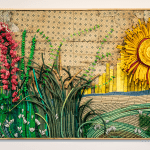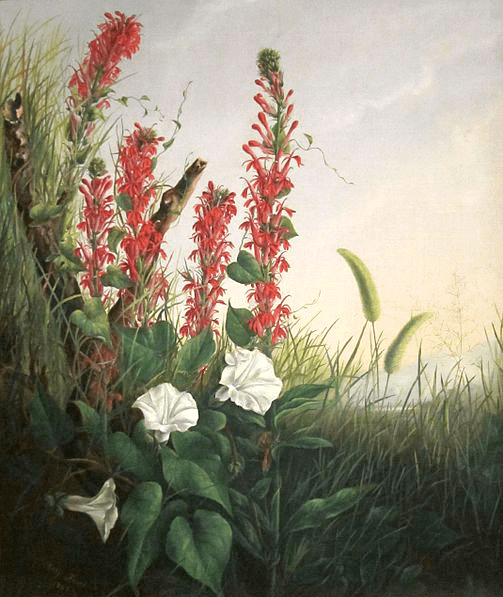Huber Heights
About the Huber Heights Art Installation and Artists
Cedric Michael Cox (b. 1976) American, PARADE, Acrylic, hand embellished digital print on canvas, Collection of the Dayton Metro Library, 2023.1
In 2022, the Dayton Metro Library was able to commission site-specific artwork for this library. In a partnership with The Dayton Art Institute, Growing Flowers and Antelope Head Puppet in the museum’s permanent collection were chosen by this artist as inspiration for this work.
About the Artists
CEDRIC MICHAEL COX | Cincinnati artist Cedric Michael Cox works in a style that falls between surrealism and abstract representation. In this work, Cox employs a rhythmic approach to form and balance as positive
and negative spaces interweave and interact with each other, creating a greater whole. Parade symbolically echoes the library’s vision of community.

Mel Rea (b.1972) American, ANTELOPING WITH BIRDIE, 2023, Acrylic, china marker, and acrylic gouache, Collection of the Dayton Metro Library, 2023.3
In 2022, the Dayton Metro Library was able to commission site-specific artwork for this library. In a partnership with The Dayton Art Institute, Antelope Head Puppet from the museum’s permanent collection was chosen by this artist as inspiration for this work.
About the Artist
MEL REA | Cleveland artist Mel Rea works in an intuitive, abstract style. Her subject matter emerges from the conversation that develops between the geometric and organic shapes that she paints in multiple layers. Rea’s paintings often have a whimsical quality reflected in her sometimes humorous and sometimes contemplative titles.

Ann B. Kim (b.1983) Korean American, MAY THE WIND BRING YOU PEACE, 2023, Acrylic, graphite and collage on panel, Collection of the Dayton Metro Library, 2023.2
In 2022, the Dayton Metro Library was able to commission site-specific artwork for this library. In a partnership with The Dayton Art Institute, Growing Flowers and Watchtower from the museum’s permanent collection were chosen by this artist as inspiration for this work.
About the Artists
ANN KIM | Dayton artist, Ann Kim creates harmonious work from fragmented parts. She achieves a spontaneous yet delicate feel as she juxtaposes images in layers varying in their translucency and saturation. Here, she uses the inspiration artworks as a springboard to reflect on ideas of cultural fluidity.
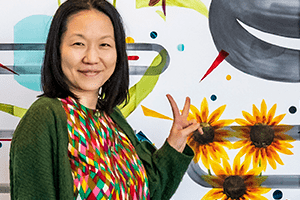
Michelle Stitzlein (b. 1967) American, MELLIE’S MEADOW, 2023, Repurposed materials, Collection of the Dayton Metro Library, 2023.4
In 2022, the Dayton Metro Library was able to commission site-specific artwork for this library. In a partnership with The Dayton Art Institute, Growing Flowers from the museum’s permanent collection was chosen by this artist as inspiration for this work.
About the Artist
MICHELL STITZLIEN | Baltimore, Ohio artist Michelle Stitzlein creates art using repurposed materials and found objects to depict imagery inspired by the natural world. These objects, once assigned and confined to a certain function or task, find a new aesthetic incarnation within her work as color, texture, form and pattern. Through the process of cutting, dismantling and placement, she coaxes the multiple, disparate objects into unusual relationships to unite as a bold, visual whole.
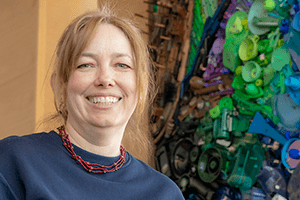
The Stories Behind the Huber Heights Art Inspiration
From the Collection of the Dayton Art Institute
MARY FORRER PEIRCE (1838–1929) American, Growing Flowers, 1869, Oil on canvas, 24 x 20 ¼ inches, The Dayton Art Institute, Gift of Suzanne Jordan Morris through her sister, Jean Jordan Phillips,
1942.33
Ohio native Mary Forrer Peirce studied painting at the Cooper Institute in New York in 1860. After travelling and studying in Europe, Peirce returned to Dayton where she steadily gained a reputation as an accomplished painter and teacher. She is best known for her landscape and nature scenes as seen here. Peirce also founded and was an active member of Dayton’s Decorative Arts Society.
View this artwork and learn more by clicking here, opens a new window or visit The Dayton Art Institute.
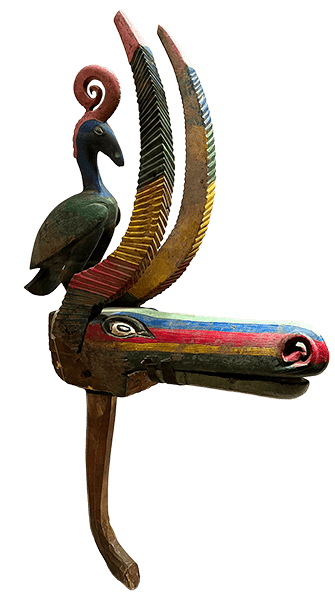
BOZO PEOPLE (MALI), Antelope Head Puppet, 20th century, Paint, wood, iron, and rubber, 26 1/2 inches, Museum purchase, 1998.94
This is a rod puppet, which would be used behind a screen or on a large mobile stage. Brightly colored figures would be used to act out plots and give messages of leadership, heroism and community relationships. The boundaries between secular and sacred performances are not always clear. In both private religious ceremonies and public spectacles, displays of art lead communities to reflect upon their values and their history.
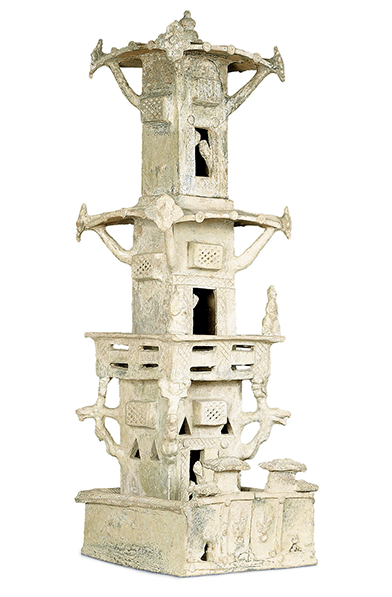
CHINESE, Eastern Han dynasty (25-220), Watchtower, 2nd century, Earthenware with green glaze, 44 1/2 x 13 1/2 x 16 inches, Museum purchase in recognition of all The Dayton Art Institute volunteers and in special memory of Kit Johnston, 1992.18
In preparation for a spirit’s journey into the afterlife, ancient Chinese furnished their tombs with foods, figurines, and models of objects used during their lifetime. As a lookout for defense or entertainment, this four-story model represents a freestanding watchtower built within an estate. The bird on top of the tower is an auspicious omen, one of the four animals symbolizing the four cardinal directions in cosmology. The architectural details – brackets supporting heavy roofs, latticed windows above the doors, rosette finials and tiles on the roofs – represent the advanced architectural development of second century China.
How did these pieces inspired our artists?
“Inspired by elements in the romantic nature scene Growing Flowers by Mary Forrer Peirce and the hard geometric vibrantly colored Antelope Head Puppet from the Bozo people of West Africa, Parade is a vivid celebration of the happiness of discovery.” Cedric Michael Cox, artist
“Inspired by Growing Flowers, I used images of wildflowers common to the Huber Heights area coexisting with wildflowers that are not indigenous to North America but have now become naturalized and grow well in the region, serving as a symbol of cultural fluidity and diversity. As an Asian-American artist, I was also drawn by the Watchtower symbolism of the bird as an auspicious omen in East Asian cosmology and wanted to seamlessly blend them with the signifiers of the regional flora.” Ann Kim, artist
“I’m visually charmed by the humor and bravado of the Antelope Head
Puppet created by the Bozo people of Mali. I feel an aesthetic kinship to
the color, shape, and bold attitude.” Mel Rea, artist
“Inspired by the beauty of native plants and the importance of protecting pollinators, I created this piece in homage to fellow Ohioan, Mary Forrer Peirce (Mellie). Expanding on Peirce’s imagery, I imagined a pastoral landscape and utilized repurposed materials in the hope that we as a society become more sensitive to environmental sustainability.”
Michelle Stitzlein, artist
Thank you to our partner,
the Dayton Art Institute, opens a new window.
Photos of ReImagining Works pieces taken by Andy Snow.


